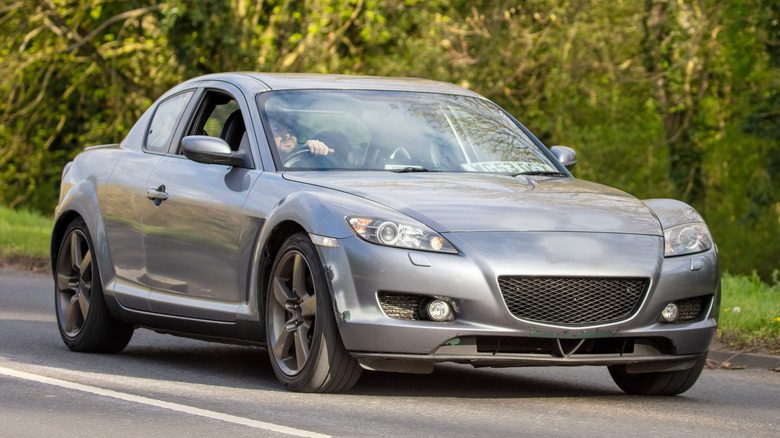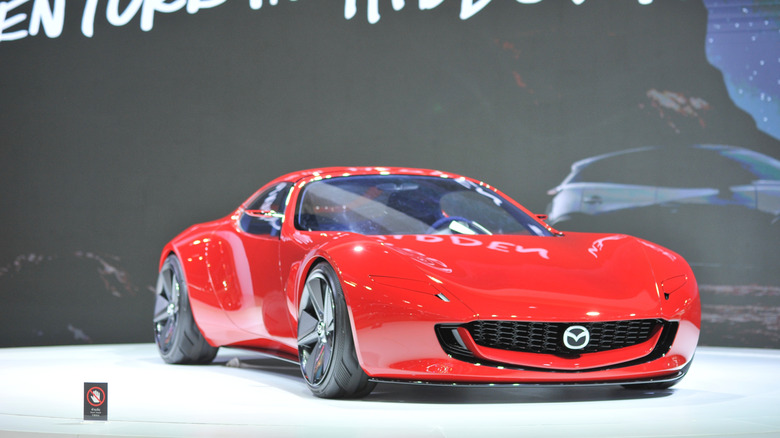Is Mazda Really Bringing Back The Rotary Engine? Here's What The Company Says
The rotary engine has been a Mazda staple since 1967. It powered one of the most famous and eccentric Japanese sports car line-ups, the RX-series, until 2012 when Mazda discontinued pure rotary-powered cars with the RX-8. Designed by Felix Wankel, the engine was actually originally utilized in the NSU Spider before Mazda committed to iterating upon its design. Numerous other companies besides Mazda experimented with rotary power (some more successfully than others). Only the Japanese automaker made it stick, though, with the rotary now featuring decades' worth of development and improvements thanks to Mazda's efforts. Sadly, it wasn't enough to keep the company using the rotary – the engines were simply too inefficient to meet modern emission regulations.
Although discontinued in 2012, Mazda has continued to experiment with the rotary engine. The company have since released a number of teases and concept cars boasting rotaries, like the RX-Vision and Iconic SP. Then, in February 2024, Mazda reinstated the "RE Development Group," the company's research arm dedicated to rotary engines. So, not only is Mazda promoting its rotary engine as part of its future corporate image concerning sports cars, but it's actively putting real money behind these projects and has done so for at least a year. This would suggest that, despite not having committed to anything, Mazda is trying to bring back rotary-powered cars. Mazda CEO Masahiro Moro added further weight to this speculation when he was interviewed by Car and Driver. In regards to the concerns about the rotary engine's emissions, Moro said, "It's a high hurdle, but in the last year, progress has been very encouraging."
What models could be rotary powered?
Mazda principally used the rotary engine to power sports cars in the past; the engine was fitted to the Cosmo, RX-series, and several race cars and concept supercars like the 787B and Furai. Owing to its compact size and excellent power output, the engine seemed ideal for smaller platforms, but Mazda wasn't shy about using it to power vehicles with other body styles. In fact, the company experimented with several unique models to varying levels of success from the compact Rotary Pickup to the full-size Roadpacer sedan. Mazda even produced a rotary-powered bus, called the Parkway Rotary 26 (one of the rarest Mazdas ever made).
The 1970s quickly became the rotary engine's zenith, thanks to models like the Cosmo, Luce, and RX-3. And the company hasn't given up on the rotary to this day, especially when it comes to sports cars. What's more, despite Mazda officially ending its run of rotary-powered cars in 2012, there remains a diverse array of aftermarket support. Today's rotary-powered Mazdas enjoy everything ranging from legacy parts to entire dedicated shops that offer various services.
What all this means for rotary-powered Mazdas in the future remains to be seen – officially, at least. The nice thing about rotary engines is that they're small. So, theoretically, Mazda could fit a rotary into almost any future platform, although it is most likely that the brand's sports cars will be the first to have a rotary engine. The main question is whether or not the engine will ever be viable with today's economic climate and efficiency restrictions. That being said, according to Masahiro Moro's statements, the future certainly looks surprisingly bright for the rotary engine.

